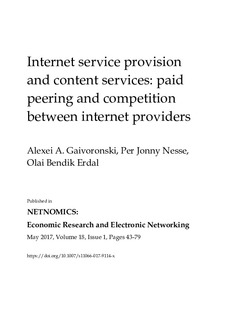| dc.contributor.author | Gaivoronski, Alexei A. | |
| dc.contributor.author | Nesse, Per Jonny | |
| dc.contributor.author | Erdal, Olai Bendik | |
| dc.date.accessioned | 2018-04-17T12:05:17Z | |
| dc.date.available | 2018-04-17T12:05:17Z | |
| dc.date.created | 2017-06-13T13:30:13Z | |
| dc.date.issued | 2017 | |
| dc.identifier.citation | Netnomics. 2017, 18 (1), 43-79. | nb_NO |
| dc.identifier.issn | 1385-9587 | |
| dc.identifier.uri | http://hdl.handle.net/11250/2494482 | |
| dc.description.abstract | We consider the relationship of Internet service providers (ISP) and content service providers (CP) in the Internet ecosystem. Currently, the position of ISPs is challenged by the emergence of powerful content service providers, especially with the spreading of bandwidth-demanding video services. The further investment in the network capacity may be hindered by prevailing business models that largely exclude the ISPs from sharing in the major cash flows resulting from content provision. We develop modeling tools for evaluation of business models of ISPs and present results of an analysis of two models with the potential for the generation of additional cash flows for ISP: paid content peering and service differentiation. Firstly, we show that under certain conditions on the cost structure and the level of demand elasticity and uncertainty, it can be profitable for a powerful content provider to resort to paid content peering, thus transferring to the ISP a part of his content provision revenue. The resulting business model may provide substantial benefits to all major participants in this ecosystem: network providers, content and service providers and end users. After this we consider competition in the Internet provision sector and show that - also in this case - the paid content peering can help ISPs to expand the network capacity and at the same time increase profits of content providers. The end users benefit from the lower prices for content services. Finally, we consider the situation when an ISP differentiates the service offer by engaging in content provision, thus entering in direct competition with content providers. | nb_NO |
| dc.language.iso | eng | nb_NO |
| dc.publisher | Springer Verlag | nb_NO |
| dc.title | Internet service provision and content services: paid peering and competition between internet providers | nb_NO |
| dc.type | Journal article | nb_NO |
| dc.type | Peer reviewed | nb_NO |
| dc.description.version | acceptedVersion | nb_NO |
| dc.source.pagenumber | 43-79 | nb_NO |
| dc.source.volume | 18 | nb_NO |
| dc.source.journal | Netnomics | nb_NO |
| dc.source.issue | 1 | nb_NO |
| dc.identifier.doi | 10.1007/s11066-017-9114-x | |
| dc.identifier.cristin | 1475725 | |
| dc.description.localcode | This is a post-peer-review, pre-copyedit version of an article published in [Netnomics] Locked until 8.6.2018 due to copyright restrictions. The final authenticated version is available online at: https://link.springer.com/article/10.1007%2Fs11066-017-9114-x | nb_NO |
| cristin.unitcode | 194,60,25,0 | |
| cristin.unitname | Institutt for industriell økonomi og teknologiledelse | |
| cristin.ispublished | true | |
| cristin.fulltext | postprint | |
| cristin.qualitycode | 1 | |
